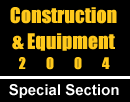
Surveys
Awards
DJC.COM
March 25, 2004
How ergonomics can fatten the bottom line
StewartPrezant Ergonomics Group

Stewart
|
It has been demonstrated in numerous industries that “work” designed on sound ergonomic principles results in substantial business benefits, including increases in productivity, improved product quality, decreased rework, improved efficiency and less wasted time.
In today's business world, companies are focused on producing more with less while increasing profit margins. Ask any site superintendent what they are accountable for and you will hear terms like “on-time delivery,” “quality,” “reduced scrap” and “improved profit margins.” Ergonomics is not even in their vocabulary and it seems that injuries are assumed to be a cost of doing business.
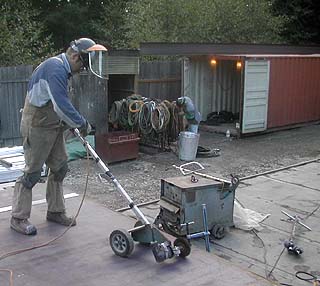
Nichols Brothers Boat Builders workers attached a drill motor to a golf bag cart to perform grinding tasks — saving them from working on their knees while doing the job 70 percent faster.
|
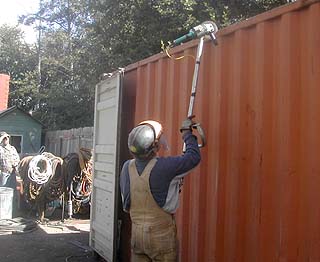
Nichols Brothers workers attached a handheld grinder to an extension handle, eliminating kneeling, back flexion and overhead work while improving productivity up to 5,000 percent.
|
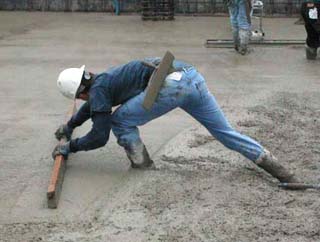
Manual rodding, sometimes the only way to get the job done, takes a lot of time and requires awkward postures and repetitive, high-pinch forces, as this worker is demonstrating.
|
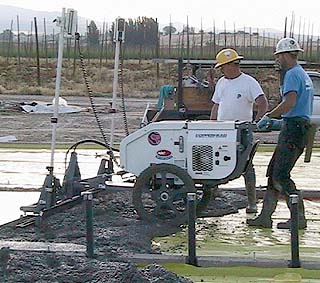
Photos courtesy of StewartPrezant Ergonomics Group
Popoff Inc. workers use a self-propelled laser screed, requiring minimal pushing and pulling while producing a higher quality finish in less time. |
In the construction industry, you may hear, “Ergonomics won't work in construction because the work is too physical and can't be changed.” With the continued focus on increasing profits and reducing costs, the value of ergonomics needs to be demonstrated in language that management understands — MONEY.
So we need to ask, “What is the value of our ergonomic effort and can we demonstrate that value in dollars?”
Combining ergonomics with production philosophies such as “Five S,” “Lean,” and “Six Sigma” creates a winning combination to improve efficiency and business performance. These high-level initiatives began in manufacturing but are now being used in shipyards, health care, forest products and other industries. They share the common goals of “improvement” and “reducing waste,” where waste is defined as any human activity that absorbs resources but does not add value.
Good planning and work organization are key elements to reducing waste. On a construction site, how often are materials delivered far from where they are needed, requiring them to be transported either mechanically or manually across the site? Time is wasted, unnecessary machinery may be used, and the extra manual material handling may result in an injury.
These are all examples of waste.
Concrete slump provides another example. If the slump is unnecessarily low, it will be more difficult to spread, creating unnecessary physical work for laborers. The spreading process may also take longer. Planning for the appropriate slump is essential to reducing excess physical work.
Successful integration of ergonomics and “lean” in an industry that shares some of the heavy physical challenges faced in construction is in the ship building and repair industry. At Todd Pacific Shipyards, workers hang coils of hose on a portable pallet-mounted “tre” to make them quicker and easier to reach.
Todd Pacific's improvement in business performance may have an application in construction as well.
For ergonomics to be considered a business necessity, its value must be demonstrated in terms that business leaders understand. Focusing on how ergonomics can impact quality, cost, productivity, safety and worker morale helps to leverage ergonomics into a position of higher visibility.
People are the most valuable part of any business. Fitting “work” to the people that do it is a must for world class businesses.
Kate Stewart is principal of the StewartPrezant Ergonomics Group and faculty member in the Department of Environmental and Occupational Health Sciences at the University of Washington.
Other Stories:
- Spiking costs shadow construction market
- Beware of vulnerabilities during construction
- Construction industry struggles to accept ISD
- The roots of Washington's new building code
- Government takes a shine to alternative bids
- New laws have yet to stem tide of condo suits
- Sleep and safety make sound partners
- WSU students train for the Solar Decathlon
- An ACE in the hole for high schoolers
- Do you know who your successor is?
- Six ways to keep your customers happy
- More training needed for crane operators
- Shattering the myth of wired glass
- Want big profits? Make yours a high-trust company
- Equipment costs don't have to break the bank
- Listen up workers: act quickly on hearing loss
- In a lawsuit? Who's paying the lawyers?
Copyright ©2009 Seattle Daily Journal and DJC.COM.
Comments? Questions? Contact us.